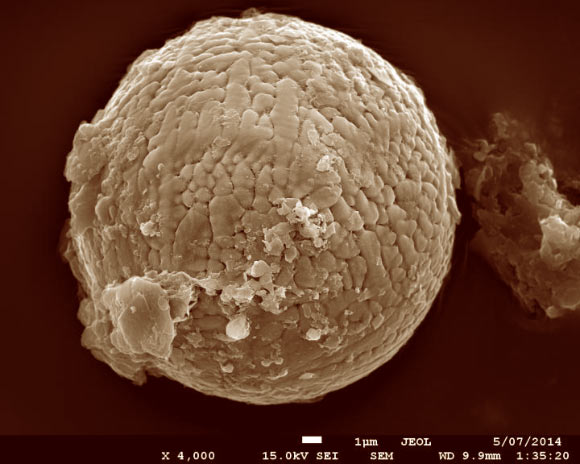An international team of researchers from Australia and the United Kingdom has made a surprising discovery about the chemistry of Earth’s upper atmosphere in the Archean era, about 2.7 billion years ago.

One of 60 ancient micrometeorites from the Pilbara region in Western Australia. Image credit: Andrew Tomkins.
The study, led by Monash University scientist Andrew Tomkins, indicates that Archean Earth’s upper atmosphere contained about the same amount of oxygen as today, and that a methane haze layer separated it from an oxygen-starved lower atmosphere.
These findings, published in the May 12 issue of the journal Nature, challenge the accepted view that Earth’s atmosphere was oxygen poor 2.7 billion years ago.
“It is widely accepted that Earth’s early atmosphere contained less than 0.001% of the present-day atmospheric oxygen level, until the Great Oxidation Event resulted in a major rise in oxygen concentration about 2.4 billion years ago,” Dr. Tomkins and co-authors said.
“There are multiple lines of evidence for low oxygen concentrations on early Earth, but all previous observations relate to the composition of the lower atmosphere in the Archean era; to date no method has been developed to sample the Archean upper atmosphere.”
The team analyzed 60 ancient micrometeorites — the width of a human hair — that had fallen on Earth billions of years ago, which were eventually encased in limestone deposits. They were collected in the Pilbara region in Western Australia.
“These micrometeorites formed when sand-sized particles entered Earth’s atmosphere and melted at altitudes of about 75 to 90 km (given an atmospheric density similar to that of today),” the scientists said.
“Using cutting-edge microscopes we found that most of the micrometeorites had once been particles of metallic iron – common in meteorites – that had been turned into iron oxide minerals in the upper atmosphere, indicating higher concentrations of oxygen than expected,” Dr. Tomkins explained.
“This was an exciting result because it is the first time anyone has found a way to sample the chemistry of the ancient Earth’s upper atmosphere.”
The team performed calculations that showed oxygen concentrations in the upper atmosphere would need to be close to modern day levels to explain the observations.
“Our model of atmospheric micrometeorite oxidation suggests that Archean upper-atmosphere oxygen concentrations may have been close to those of the present-day Earth, and that the ratio of oxygen to carbon monoxide was sufficiently high to prevent noticeable inhibition of oxidation by carbon monoxide,” they said.
“The anomalous sulfur isotope signature of pyrite in seafloor sediments from this period, which requires an anoxic surface environment, implies that there may have been minimal mixing between the upper and lower atmosphere during the Archean.”
“A possible explanation for this layered atmosphere might have involved a methane haze layer at middle levels of the atmosphere,” Dr. Tomkins said.
“The methane in such a layer would absorb UV light, releasing heat and creating a warm zone in the atmosphere that would inhibit vertical mixing.”
The next step will see the team looking for micrometeorites within rocks of different ages to search for changes in the ancient atmosphere when oxygen started to be produced by photosynthetic organisms 2.5 billion years ago in the Great Oxidation Event.
_____
Andrew G. Tomkins et al. 2016. Ancient micrometeorites suggestive of an oxygen-rich Archaean upper atmosphere. Nature 533, 235-238; doi: 10.1038/nature17678







